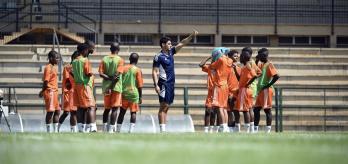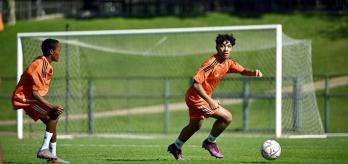Methodology
The intention: What is practised?
The main objective of the exercise is to enhance the players’ ability to secure and retain possession as a central unit. Other aspects, such as running with the ball and creating and finishing chances, do not feature in this particular exercise.The practice specifically emphasises unit and individual skills such as combination play, making good use of space, creating multiple passing options by knowing when to drift or drop and receiving with the correct body posture to turn out of pressure when in central areas. The focus on support play and creating space for themselves and their team-mates broadens player skills into the unit scale. It also focuses on marking and tracking opponents, while seeking opportunities to press and regain possession.
The scale: For whom is this relevant?
This practice specifically emphasises the unit scale, focusing on the use of space and quick combination play in central areas of the pitch. The possession game is particularly relevant for centre-midfielders seeking to support the build-up by offering to receive between the lines. Conversely, players outside the opposition's structure, like center-backs or full-backs, are positioned on the periphery, aiming to advance the ball and provide support for those operating within. In addition to securing possession as a unit, the practice also develops a unit’s ability to transition to defend and press and regain the ball.
The practice type: How is the practice designed?
This practice is structured as an opposed possession game, offering abundant opportunities for the unit to refine combination play in tight spaces on the pitch. The focal point, reiterated consistently, is the execution of intricate combinations within condensed central areas. Central players are assigned the responsibility of creating passing options, securing possession, and redistributing the ball. Due to the heightened time constraints and opposition pressure imposed by the game, players must continuously process information, make swift decisions, and execute actions with precision. While the game lacks a predetermined direction, specific rules compel central players to pivot with the ball, continually shifting the point of attack.
Session plan
Organisation
-
Mark out four 10x10m squares inside a 20x20m exercise area.
-
Divide the group into 3 teams of 4 players (blues, oranges and greens).
-
Place a blue player on the outside of each side of the exercise area.
-
Position the remaining players (4 green and 4 orange players) inside the exercise area.
Explanation
-
The in-possession team (oranges) aim to retain possession within the exercise area, with the objective of connecting with all 4 outside (blue) players in turn.
-
The oranges must occupy 3 of the 4 squares at all times.
-
The ball cannot be passed directly between outside players.
-
The green team’s objective is to win the ball back. Once they recover possession, they become the in-possession team and the two teams swap roles.
-
Once the in-possession team have connected with all 4 outside players, the out-of-possession team swap roles with the outside team.
Variation
-
The ball can be played directly between outside players. However, a pass played between outside players does not count as one of the in-possession team’s 4 passes.
Key coaching points
Roles of coaches
-
First coach: leads the session and instructs the players. The coach intervenes, providing the players with pointers and asking them questions to help them to think about where they should look to create space.
-
Second coach: is not actively involved, mainly observes from a position outside the playing area and offers encouragement.
-
Third coach: observes from a position outside the playing area and offers encouragement.















